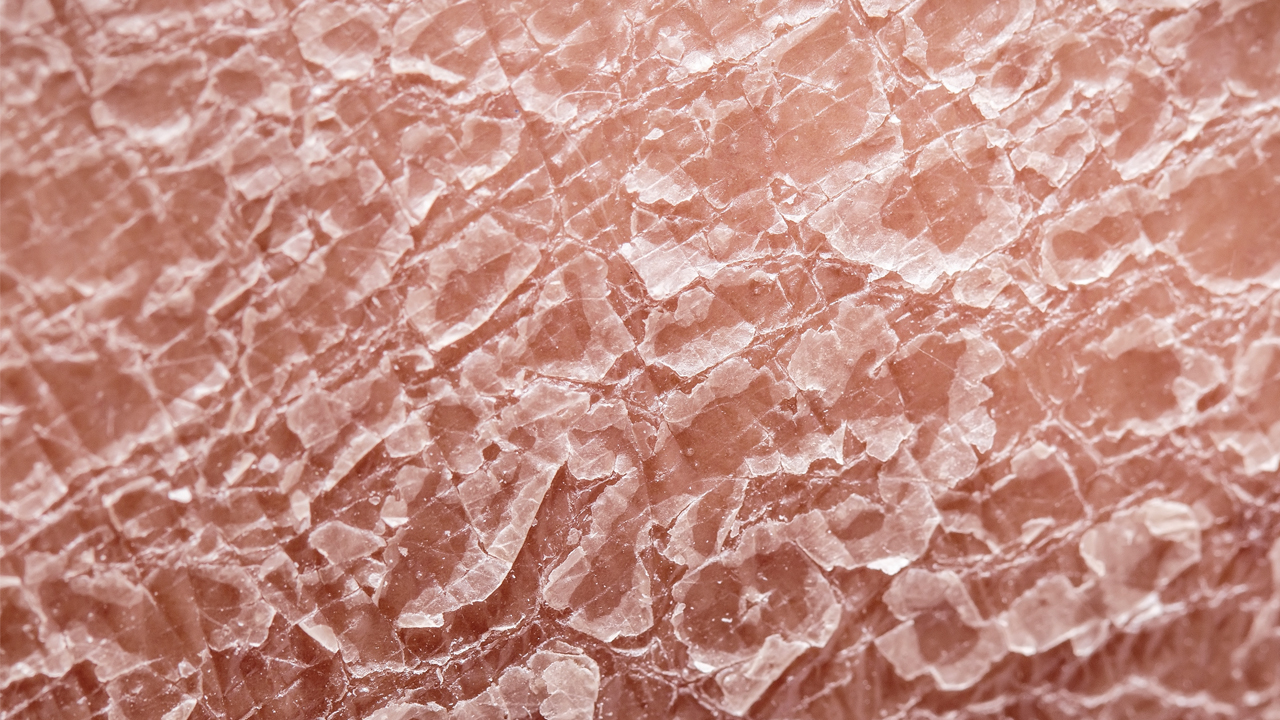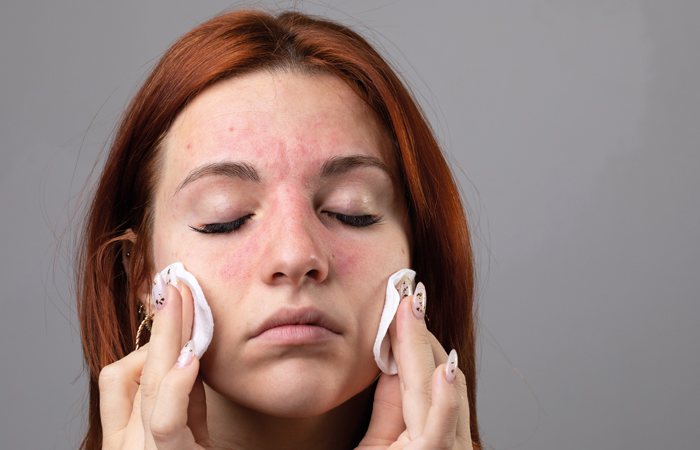In OTC
Follow this topic
Bookmark
Record learning outcomes
Did you know that the average adult has around 22 square feet of skin? As the largest organ in the body, it has a variety of functions: protecting against pathogens, regulating temperature, storing fat and water and vitamin D production, to name a few. It also allows us to experience different sensations; in fact, there are around 1,000 nerve endings in a typical square inch of skin.
However, like any complex network, issues can arise. “Skin conditions are extremely common in the UK, and around half the population will experience some sort of skin problem in a 12-month period,” says Dr Jonathan Kentley, consultant dermatologist and British Skin Foundation (BSF) spokesperson, Chelsea and Westminster Hospital. “As skin disease can be extremely visible and is often associated with symptoms such as itch, this can often have a huge impact on people’s quality of life, affecting sleep, mood and self-confidence.” Common conditions include eczema – which affects around 20 per cent of children and 10 per cent of adults in the UK – psoriasis, rosacea and acne, adds Dr Kentley. Problems can also be caused by infections, which may be bacterial, fungal or viral. While skin complaints are certainly not confined to the winter, many can be exacerbated by the cold. “There are also more rare conditions such as cold urticaria (hives) that can be provoked by low temperatures,” says Dr Kentley.
Fortunately, there are many ways that pharmacy teams can help patients, from discussing self care steps and OTC treatment options (while keeping in mind potential contraindications), to signposting to support organisations. But how does the skin work?
“Around half the population will experience some sort of skin problem in a 12-month period”
A deep dive into the skin
“The epidermis is the top layer of the skin, which acts like a physical barrier,” says professor Carsten Flohr of the British Association of Dermatologists (BAD). This helps to prevent water loss and protect against potentially harmful things such as germs and UV light. “Depending on what site on your body it’s located, epidermis can come in varying levels of thickness,” he continues. “Some areas have what is called ‘fine skin’ – for example, like the skin around our eyes. The dermis is under the epidermis, and is altogether a deeper layer of the skin, held together mainly by collagen and elastin.” Dr Kentley adds: “The dermis also contains blood vessels, nerve endings, sweat glands and hair follicles and acts to support the skin, providing strength and elasticity as well as regulating body temperature.” The subcutis lies at the base of the dermis and is mostly composed of fat and connective tissue. It stores energy and helps to insulate the body against the cold.
Common skin conditions
Dry and cracked skin
“When the temperature drops, the skin struggles to retain moisture which can lead to itchy, dry and cracked skin,” says Dr Kentley. “Many people use central heating, which creates a dry heat that may remove moisture from the air, making skin even more dry. Keeping the skin hydrated is essential, and it is advisable to bathe or shower using warm (rather than hot) water and apply a moisturiser straight away. During the winter, many people prefer to use a heavier moisturiser – such as a cream instead of a lotion – and may even need to use a greasy ointment on particularly dry areas such as the hands, elbows and knees.”
“For people with a chronic skin condition that is susceptible to the cold, such as eczema or rosacea, it will be useful to get to know your triggers,” says professor Flohr. “What causes your skin to become more dry, or itchier, and what can you do to relieve that. General advice includes, as well as moisturising, making sure to wrap up warm so the skin is protected from the elements that might cause it to dry out, and avoiding wearing harsher fabrics next to the skin. To take it a step further, for people struggling with dryness, you may want to swap to a soap-free cleanser, or a soap substitute, especially for washing your hands or in the shower.”
Eczema
Flare-ups can occur at any time, but many patients may find their condition deteriorates during the colder months. “People with eczema already suffer from dry skin and itch, which may significantly worsen due to temperature changes for the reasons discussed earlier,” says Dr Kentley. “The skin barrier in eczema is already disrupted, meaning that even more water can be lost from the skin during the winter months – therefore it is important to proactively moisturise to prevent flares and treat any flare-ups promptly.”
“It is important to recognise that skin disease can often have a huge impact on emotional wellbeing”
Rosacea
This chronic inflammatory skin condition affects around five to 10 per cent of people in the UK, and can be triggered by cold or hot temperatures, as well as things such as sunlight, spicy food, alcohol or stress. “Rosacea is thought to have a genetic predisposition and is related to overactivity of the neurovascular system, where certain triggers activate nerve endings, causing flushing and redness,” explains Dr Kentley.
“It has also been shown that people with rosacea have higher levels of Demodex mites in their hair follicles, and it is thought that the immune system overreacting to this is also a driver of the condition.
“One of the most important ways to manage rosacea is through gentle skincare which is kind to the disrupted skin barrier, such as fragrance-free cleansers and moisturisers, avoiding potentially irritating products such as retinoids and hydroxy acids. As UV light is a major driver of rosacea, using a high SPF sunscreen is also important. Products such as azelaic acid help reduce inflammation in the skin, and niacinamide as well as polyhydroxy acids can help the skin barrier repair.”
Patients presenting with symptoms of rosacea should see their GP, who may suggest a topical treatment or antibiotics, or referral to a dermatologist. “Recently, Soolantra (a cream version of ivermectin) has been shown to be helpful in reducing the number of Demodex mites in the skin and therefore reducing symptoms,” reveals Dr Kentley. “The redness of rosacea can often be difficult to manage, and treatment with vascular lasers or intense pulsed light may be used. People with rosacea may find benefits in learning to manage their triggers so they don’t get a flare-up,” says professor Flohr. “For more information on self care, we have a patient information leaflet that might help: skinhealthinfo.org.uk/condition/rosacea.”
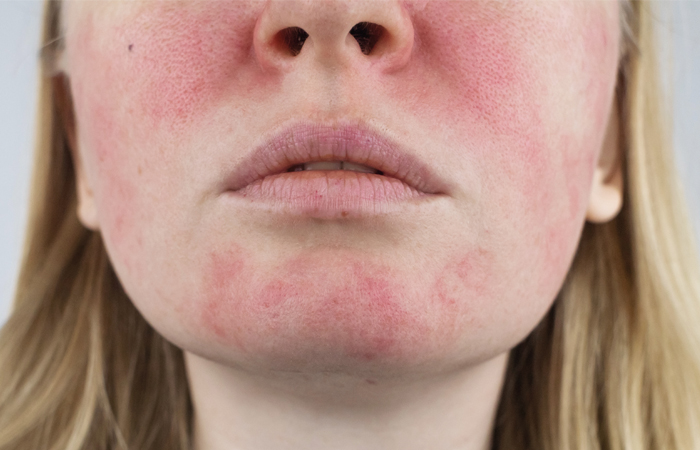
Remind customers with rosacea to avoid scrubbing or rubbing their face to avoid irritation.
“One of the most important ways to manage rosacea is through gentle skincare which is kind to the disrupted skin barrier, such as fragrance-free cleansers and moisturisers”
Advice on acne
As well as being physically painful, acne can take a significant toll on mental health. With the UK being within the top 10 countries of acne sufferers in 2021 (with 14.65 per cent of adolescents and young people affected) there is plenty of opportunity for pharmacy teams to support their communities.
Alongside offering guidance and recommendations for over-the-counter products and self care tips, pharmacy teams can suggest onward referral to dermatologists and signpost to further support. This certainly can include support for mental health too, and there is plenty of options available, including: youngminds.co.uk for support with acne and mental health; britishskinfoundation.org.uk to read skin stories by real people; acnesupport.org.uk for more on emotional support.
Windburn & sunburn
Wintery weather can cause redness and irritation in the form of windburn. It occurs when cold, dry air damages the skin, resulting in a ‘burning’ sensation or dryness. Patients with existing conditions such as eczema and psoriasis may be at higher risk. In mild cases, patients can usually expect to see an improvement in a few days with some simple self care steps. These include restricting time outdoors, applying moisturiser, using a humidifier at home if available, and drinking water to rehydrate. However, if the pain is severe, the affected area is large, or the patient is a young child – or if they have symptoms such as fever, headache or sickness – then medical attention should be sought.
Perhaps surprisingly during the chillier months, windburn can also be linked to sunburn. As the outer layer gets damaged and flakes off, the newly exposed skin is more vulnerable to UV radiation. And that’s not all: according to the Met Office, snow reflects around 85 per cent of the sun’s UV rays. So, customers spending time outdoors – skiing, working or just enjoying winter walks – should apply sunscreen.
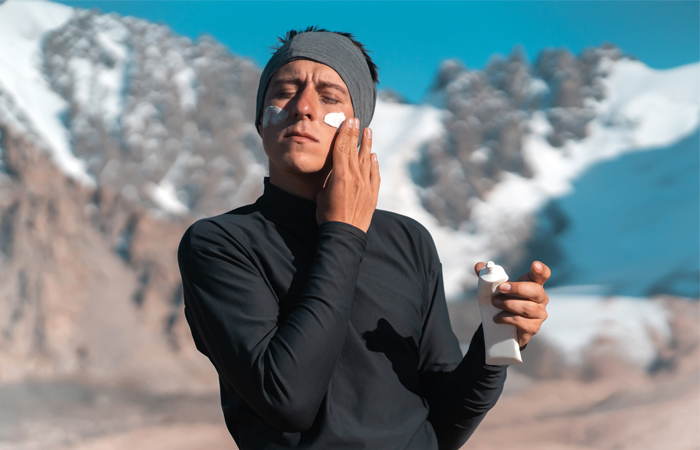
Despite low temperatures, customers should still be encouraged to wear SPF to avoid sun damage, especially when doing outdoor activities.
Chilblains
Exposure to the cold can lead to inflamed, itchy patches of skin – often on extremities such as fingers and toes – which may look reddish or purple. They’ll usually resolve by themselves in a fortnight or so, but a soothing lotion such as calamine can help relieve itching, and the NHS site says that paracetamol or ibuprofen can ease the pain. Patients should resist the urge to scratch chilblains, and avoid going out in the cold where possible (failing that, they should wrap up warm). Refer to a GP if the problem persists or recurs, there is pus or a fever, or the patient is diabetic.
Lip service
Lips have more than a million nerve endings, and the skin there is thinner than on other parts of the body such as the hands, so they’ll need plenty of TLC during the colder months. “A lip balm may be helpful for preventing moisture loss,” says Dr Jonathan Kentley, consultant dermatologist and British Skin Foundation (BSF) spokesperson, Chelsea and Westminster Hospital. Pharmacies will often stock these in a range of convenient formats, from sticks to tubes to pots. Meanwhile, cold sores – caused by the herpes simplex virus – can be a nuisance throughout the year. Once infected with the virus, it can flare up at any time, though individual triggers will vary. Some patients may find strong sunlight is a factor, in which case it may be less of an issue as the days grow darker. However, other triggers – for example, stress or illness (such as flu) – may be more likely in winter.
Cold sores usually clear up within 10 days, though they’ll be contagious in the meantime, so patients should avoid kissing others – especially babies – or touching the affected area. Cold sore cream (e.g. aciclovir) is available from the pharmacy to help with soothing and healing (hands should be washed well both before and after applying) and should ideally be used at the first sign of symptoms, such as tingling. If the problem persists after 10 days or is severe or very painful – or if the patient is immunosuppressed – they should see a doctor.
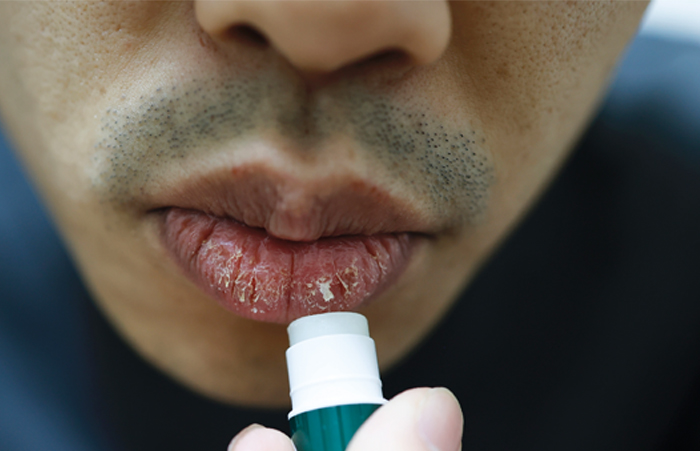
Lips can become dryand chapped during winter months, so lip balm may be helpful for preventing moisture loss.
How you can help
“Pharmacy teams play an important role in supporting patients with acute and chronic skin concerns,” says Dr Kentley. Especially with advice on how to apply topical treatments. “There are a vast number of over-the-counter preparations available for various skin concerns, and knowledge of these can be really useful when guiding which products patients should choose for their individual needs,” he adds. “It is important to recognise that skin disease can often have a huge impact on emotional wellbeing. Being aware of various support organisations for patients can be of great benefit, so that they can interact with others who may be sharing their experiences. A wealth of information is available via: britishskinfoundation.org.uk.”
Professor Flohr echoes the sentiment that knowledge is empowering. “Finding impartial advice in the internet age can be difficult, so signposting patients towards accurate information is important. The British Association of Dermatologists (bad.org.uk) publishes publicly available patient information leaflets for a wide range of conditions, which can be found online. They even have QR codes for a patient to scan and read it on their phones, if you wanted to share this with them in the pharmacy.” You could also let your pharmacist know that the Association’s educational arm, the British College of Dermatology, has launched a series of online courses on topics such as management of eczema, acne, and psoriasis for community pharmacists at: learning.bcd.org.uk.”
Skin SOS
While many skin concerns are mild and can be managed at home, there are some that require urgent medical attention, says Dr Kentley. While it isn’t possible to cover them all here, some important ones include the following: “Erythroderma, where over 90 per cent of the skin is affected by a rash, is considered a medical emergency and requires immediate assessment. Patients with widespread blistering, involvement of the mouth and eyes, and rashes associated with feeling systemically unwell should always be reviewed promptly by a medical professional. Any patient with a concerning mole or other skin lesion should be referred to a dermatologist on an urgent suspected skin cancer pathway for further evaluation.”

